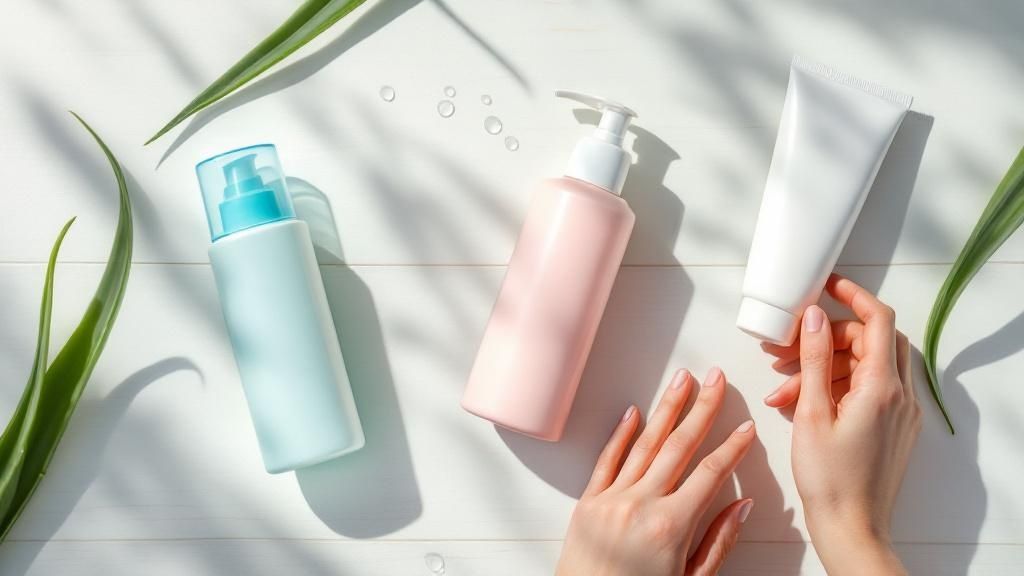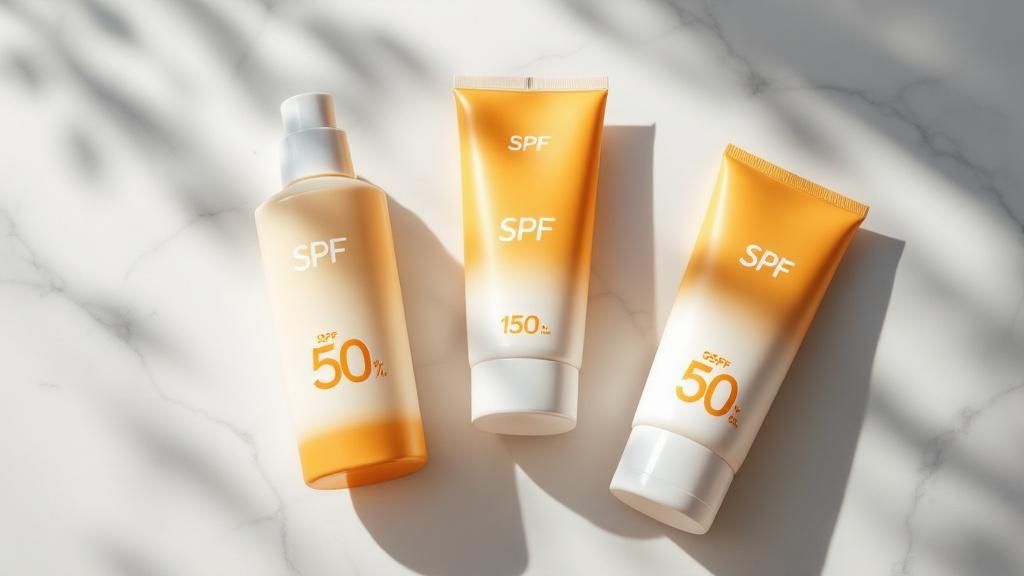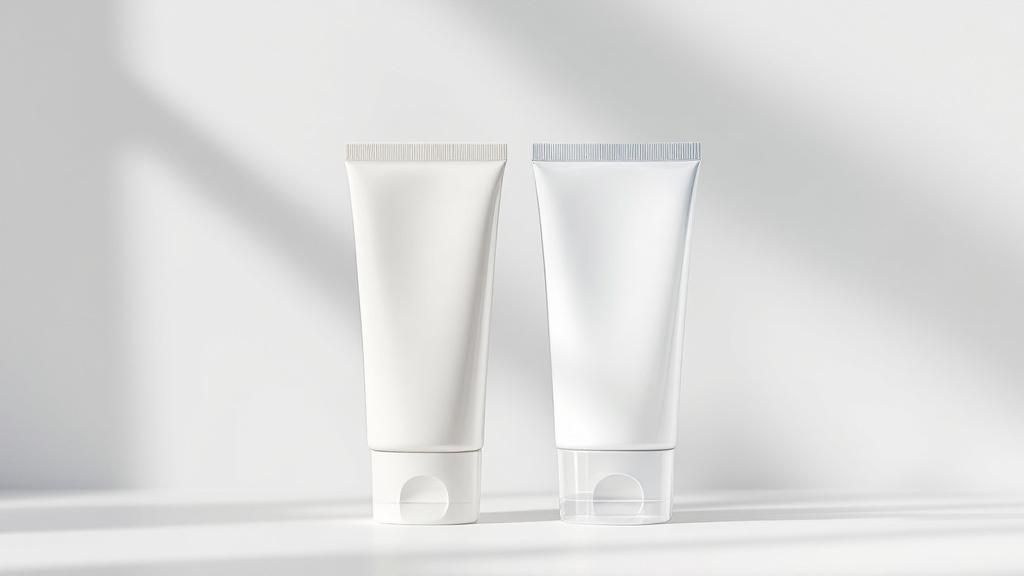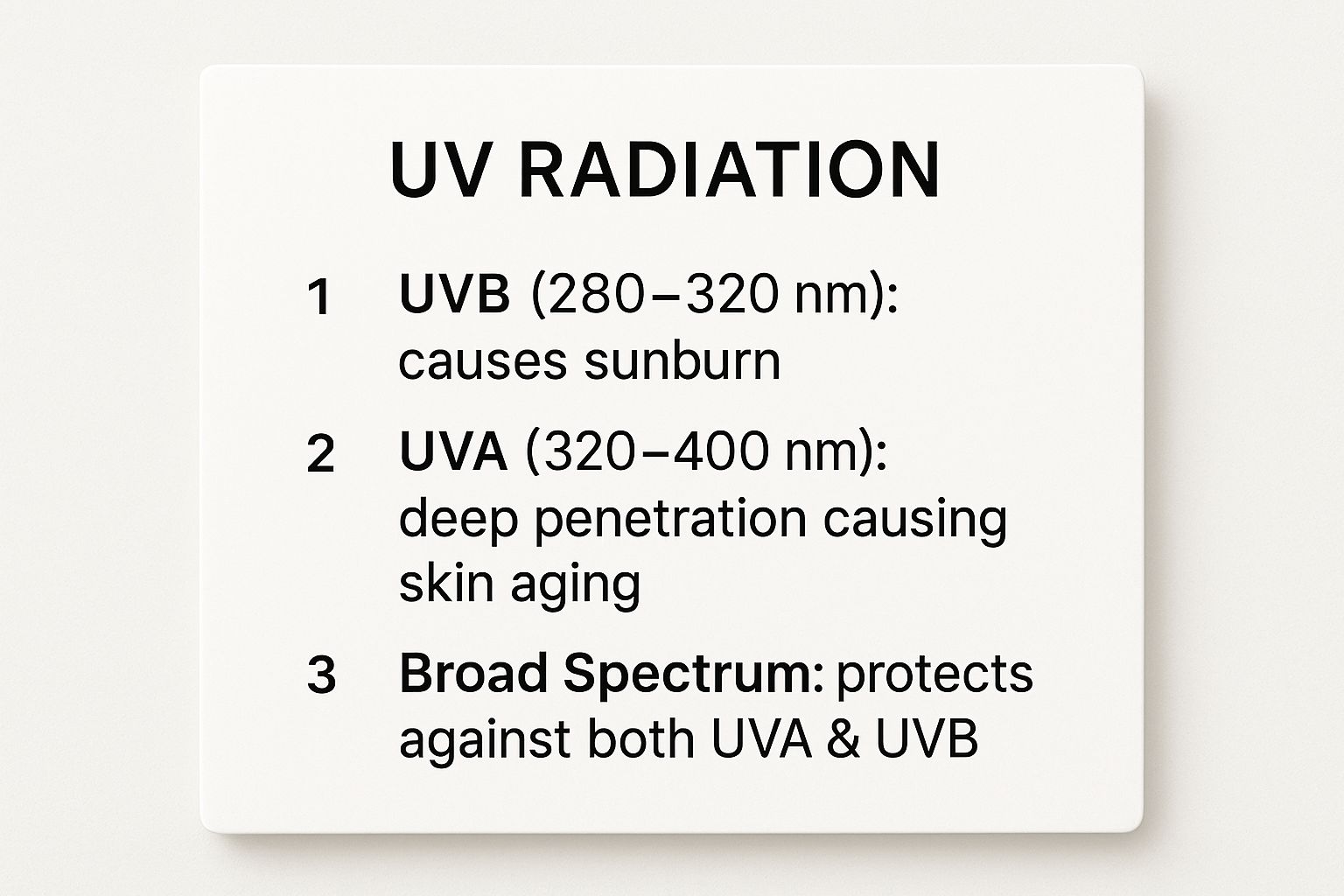
Figuring out how to choose the right sunscreen really just boils down to a few key things. You need broad-spectrum protection, an SPF of 30 or higher, and a formula that actually works with your skin. Nail these three, and you’re properly shielded from both painful sunburns and the long-term damage that sneaks up on you.
Your Quick Guide to Sunscreen Selection
Walking down the sunscreen aisle can feel overwhelming, but it doesn't need to be. The goal is simple: find a product you’ll actually want to use every single day. We're long past the days of thick, chalky lotions. Modern sunscreens, like our own BARB N.P. Sun Shield SPF 50+, are elegant, lightweight, and often packed with extra skincare benefits.
The most critical step is making sun protection an absolute non-negotiable in your daily routine, right up there with brushing your teeth. Daily, consistent application is the single most powerful thing you can do to fight premature aging and skin cancer. The best sunscreen is simply the one you'll use without fail.
For instance, a product like BARB N.P. Sun Shield SPF 50+ is designed to feel weightless and non-greasy. That makes it perfect for daily wear, whether it’s under makeup or on its own—a versatility that encourages you to never skip it.
Remember: The best sunscreen in the world is useless if it just sits on your shelf. Find a texture you love, and you’ll never miss a day of protection again.
To cut through the noise, here's a quick cheat sheet covering the absolute essentials. Use this table to make a smart, confident choice in minutes.
Sunscreen Essentials at a Glance
This table breaks down the core factors you need to consider, making it easy to grab the right bottle and go.
| Factor | What It Means | Recommendation |
|---|---|---|
| Protection Type | This tells you if it blocks both UVA (aging) and UVB (burning) rays. | Always, always choose Broad-Spectrum. Anything less leaves you exposed. |
| SPF Level | Measures how well it protects you from UVB rays—the main culprit behind sunburn. | Go for SPF 30 to 50 for everyday protection. This is the sweet spot for robust defense. |
With these basics covered, you're already halfway to finding the perfect sunscreen for your skin and lifestyle.
Decoding SPF and Broad-Spectrum Protection

Walking down the sunscreen aisle can feel like trying to decipher a secret code. But those numbers and labels hold the key to protecting your skin properly. The first thing you'll always notice is the SPF, or Sun Protection Factor. This number is all about measuring how well a product shields you from UVB rays—the ones that cause those painful, visible sunburns.
When you're trying to figure out which sunscreen to choose, the SPF value is your first major clue. An SPF 15 blocks about 93% of UVB rays, while an SPF 30 bumps that up to 97%. Going all the way up to SPF 50 gives you about 98% protection. As you can see, the jump in protection gets smaller and smaller after SPF 30.
That's why most dermatologists and aesthetic experts recommend SPF 30 as the daily minimum. It offers a solid defense against sunburns without giving you a false sense of being completely invincible to the sun. For more on the latest in sun care, check out this report from Future Market Insights.
The Importance of Broad-Spectrum Coverage
But here’s a common mistake I see people make: relying only on a high SPF. UVB rays are just one piece of the puzzle. The silent threat comes from UVA rays, which penetrate much deeper into the skin. These are the primary culprits behind premature aging—think fine lines, wrinkles, and dark spots.
This is where the term broad-spectrum protection becomes non-negotiable. If you see that on the label, it means the sunscreen has been tested and proven to protect you from both UVA and UVB rays. Without it, even a high-SPF product is only doing half the job, leaving your skin exposed to long-term damage.
Think of it this way: SPF is your defense against getting burned today. Broad-spectrum protection is your defense against looking older tomorrow.
Imagine spending a day at the beach with an SPF 50 sunscreen that isn't broad-spectrum. You might avoid a sunburn, but you're not stopping those UVA rays from breaking down your skin’s precious collagen. A truly effective anti-aging routine always, always includes a reliable broad-spectrum sunscreen.
We talk more about why Skinceuticals Sunscreen SPF 30 is a must-have in every anti-aging routine in another one of our posts.
Finding the Right Sunscreen for Your Skin Type

The secret to actually wearing sunscreen every day isn't just about the SPF number. It’s about finding a formula your skin genuinely loves. Let’s be honest, the best sunscreen is the one you’ll apply without a second thought, and that means matching the texture to your skin type is non-negotiable.
Sunscreen for Dry Skin
If your skin constantly feels tight, flaky, or thirsty, you need a formula that adds moisture, not strips it away. Look for cream-based sunscreens packed with hydrating ingredients like hyaluronic acid or glycerin. These formulas work double-duty as a moisturizer and protector, leaving your skin feeling comfortable and plump all day long.
Solutions for Oily and Acne-Prone Skin
For anyone with oily or acne-prone skin, the idea of slathering on another layer can feel like a nightmare. The trick is to find formulas labeled non-comedogenic—a fancy way of saying they won't clog your pores.
Your best friends here are lightweight gels, fluids, or oil-free lotions. They sink in fast, help manage shine, and won’t trigger new breakouts. A product like the BARB N.P. Sun Shield SPF 50+ is an excellent choice, as its non-greasy formula won't clog pores or feel heavy on the skin. If you have combination skin, a light lotion is often the perfect middle ground, hydrating drier areas without overwhelming your T-zone.
Gentle Choices for Sensitive Skin
Sensitive skin demands a gentle touch. If you deal with redness, stinging, or irritation, mineral sunscreens are an absolute game-changer. These formulas use physical blockers like zinc oxide and titanium dioxide that sit on top of the skin instead of being absorbed. Because they create a physical barrier, they're far less likely to cause a reaction.
The goal is to find a sunscreen that feels like a natural part of your skincare routine—not a chore. It should be an elegant final step that preps your skin for whatever the day holds.
For a beautiful option that works for a wide range of skin types, the BARB N.P. Sun Shield SPF 50+ is a fantastic choice. Its formula was created for a non-greasy, elegant finish, so you get serious daily protection without any compromise on comfort.
And if you’re looking to combine your moisturizer and SPF into one simple step, you can explore our ultimate guide to choosing the best face cream with SPF to learn more.
Mineral vs. Chemical Sunscreens Explained
One of the biggest questions I get is about the difference between mineral and chemical sunscreens. It’s a huge sticking point for people, but once you understand how they work, choosing the right one becomes so much easier.
Think of it this way: the two formulas protect your skin in fundamentally different ways, and your choice really comes down to your skin’s needs and what you prefer to feel on your face every day.
How They Work
Mineral sunscreens are also called physical sunscreens for a reason. They use natural minerals like zinc oxide and titanium dioxide to create a physical barrier on top of your skin. This barrier acts like a mirror, reflecting harmful UV rays away before they can even think about penetrating your skin. It’s straightforward, effective, and works the second you put it on.
Chemical sunscreens, on the other hand, have a more high-tech approach. They use organic compounds that absorb into the top layer of your skin. Instead of blocking rays, they act like a sponge, soaking up UV radiation and converting it into a tiny amount of heat that’s then released from your skin. Pretty smart, right? The BARB N.P. Sun Shield SPF 50+ is a hybrid formula, which means it uses both mineral and chemical filters to provide robust, cosmetically elegant protection.
Both are designed to offer broad-spectrum protection, which is non-negotiable for defending against both skin-burning UVB rays and the deeper-penetrating UVA rays that cause premature aging.

Mineral vs. Chemical Sunscreen Comparison
To make it even clearer, I’ve put together a quick comparison table. This breaks down the key differences at a glance, so you can see which one aligns better with your goals.
| Feature | Mineral Sunscreen | Chemical Sunscreen |
|---|---|---|
| Active Ingredients | Zinc Oxide, Titanium Dioxide | Oxybenzone, Avobenzone, Octinoxate, etc. |
| How It Works | Sits on top of skin and physically blocks UV rays. | Absorbs into skin and converts UV rays to heat. |
| Best For | Sensitive, acne-prone, or post-procedure skin. | Daily wear, active lifestyles, and under makeup. |
| Feel & Finish | Can be thicker; modern formulas are much better but some may leave a slight cast. | Lightweight, sheer, and absorbs invisibly. |
| Protection Speed | Works immediately upon application. | Needs about 20 minutes to become effective. |
Ultimately, both types are incredibly effective when used correctly. The "best" one is simply the one you'll actually wear every single day.
Which Formula Is Right for You?
So, how do you choose? It really comes down to your skin type and lifestyle.
I almost always recommend mineral sunscreens for my clients with sensitive, reactive, or acne-prone skin. Because the ingredients aren't absorbed into the skin, there’s a much lower risk of irritation or clogged pores. They're my go-to for post-procedure care, too.
Chemical sunscreens are fantastic for daily wear, especially if you dislike the feeling of product on your skin. They tend to be super lightweight and absorb without a trace, making them a dream to wear under makeup. A great example is the BARB N.P. Sun Shield SPF 50+. It’s cosmetically elegant and offers powerful protection without feeling heavy or greasy.
The most important thing is to find a formula you love. Ask yourself: Do I want gentle, immediate protection (mineral) or an invisible, lightweight finish for daily use (chemical)? You can’t go wrong with either.
The Rise of Conscious Sun Care

Let's be honest: choosing a sunscreen used to be as simple as grabbing the highest SPF you could find. Not anymore. Today, picking the right sun protection is a far more personal and thoughtful decision.
We're all making more conscious choices now, looking for formulas that do more than just block the sun—they need to align with our values and actually improve our skin's health. This shift has pushed the entire industry to innovate, moving way beyond basic UV shields.
A huge part of this movement is the demand for ‘clean beauty’ and products that don't harm the planet. We're actively flipping over bottles to look for the "reef-safe" label, making sure our sunscreen is free from ingredients like oxybenzone and octinoxate that can damage fragile marine ecosystems. It turns a simple daily habit into a small but meaningful act of environmental stewardship.
Sunscreen as Skincare
Beyond eco-concerns, the biggest trend is treating sunscreen as the final, most crucial step in a skincare routine. It's no longer just a protective layer; it's a treatment in itself. The best modern sunscreens are loaded with powerhouse ingredients that work hard all day long.
You'll often find formulas packed with extras like:
- Hydrating agents like hyaluronic acid to keep skin looking dewy and plump.
- Antioxidants such as Vitamin C or niacinamide to neutralize skin-damaging free radicals.
- Anti-aging components that help maintain skin firmness and elasticity.
This isn't just a niche trend. Research from Maia Research shows that around 70% of consumers are specifically looking for sunscreens that deliver these added skin benefits.
Choosing a sunscreen has become an extension of self-care. It’s about protecting your skin’s future while caring for your overall well-being and the environment.
A perfect example is the BARB N.P. Sun Shield SPF 50+. It gives you serious broad-spectrum protection but feels incredibly elegant and non-greasy, making it a dream for daily wear. It also contains powerful antioxidants, turning your sun protection into a true skincare treatment.
Of course, if your skin is reactive or easily irritated, finding a formula that marries these benefits with a gentle touch is non-negotiable. If that sounds familiar, you'll want to read our dedicated guide on the best sunscreen for sensitive skin for more targeted advice.
Answering Your Biggest Sunscreen Questions
Even with the perfect sunscreen in hand, the practical, day-to-day questions always come up. Getting these small details right is what transforms good sun protection into an effortless, effective habit. Let's tackle some of the most common questions I hear from clients.
How Much Sunscreen Do I Really Need to Use?
This is the number one question, and the answer is almost always: more than you're currently using. It's a hard truth, but studies show most people only apply 25-50% of the recommended amount. When you do that, you're getting a fraction of the SPF protection listed on the bottle.
To get the full defense you paid for, here are a few simple guides dermatologists swear by:
- For your body: You need about an ounce, which is roughly the amount that fills a standard shot glass.
- For your face: A nickel-sized dollop is a solid baseline.
- The Two-Finger Rule: This is my favorite trick. Squeeze a line of sunscreen down the length of your index and middle fingers. That amount is just right for your face and neck.
Remember, choosing the right product is only half the battle. Skimping on application means you're not getting the protection you think you are.
Do I Need SPF on Cloudy Days? Or When I'm Inside?
Yes, and this one is non-negotiable. It’s shocking, but up to 80% of the sun's UV radiation slices right through clouds, fog, and haze. That means you’re still exposed to skin-damaging rays even on the gloomiest days.
The same goes for when you're indoors. UVA rays—the ones responsible for premature aging and wrinkles—pass easily through window glass. Whether you're at your desk near a window or driving your car, your skin is still vulnerable to that slow, cumulative damage. Making sunscreen a daily habit, no matter the weather or your plans, is the secret to long-term skin health.
Think of daily sunscreen as an insurance policy for your skin. You don't just use it on days you think you'll need it; you use it every day for consistent, reliable protection.
What Does "Water-Resistant" Actually Mean?
People often confuse "water-resistant" with "waterproof," but in the world of skincare, they are worlds apart. Let's be clear: no sunscreen is truly waterproof or sweatproof.
The "water-resistant" label is a certification that the sunscreen maintains its SPF level for a specific time while you're swimming or sweating. The bottle will always specify either 40 minutes or 80 minutes. After that time is up, its effectiveness plummets. You absolutely must reapply after swimming, towel drying, or a heavy workout to stay protected. For regular daily life, reapplying every two hours is still the golden rule.
Can I Just Use My Body Sunscreen on My Face?
You can, but I really don't recommend it. Body sunscreens are usually formulated to be thicker, heavier, and more occlusive to cover large areas. Slathering that on your delicate facial skin often feels greasy and can lead to clogged pores—a nightmare for anyone with oily or acne-prone skin.
Facial sunscreens are designed with what we call "cosmetic elegance" in mind. Products like the BARB N.P. Sun Shield SPF 50+ are specifically created to be lightweight, non-comedogenic (meaning they won't clog pores), and to sit beautifully under makeup. Many even include extra skincare benefits, turning your daily sun protection into a luxurious final step in your morning routine.
At BARB N.P., we believe the best sunscreen is the one you genuinely love to wear every single day. Find your perfect match and explore our curated selection of medical-grade skincare by visiting our shop at https://barbnp.shop.

